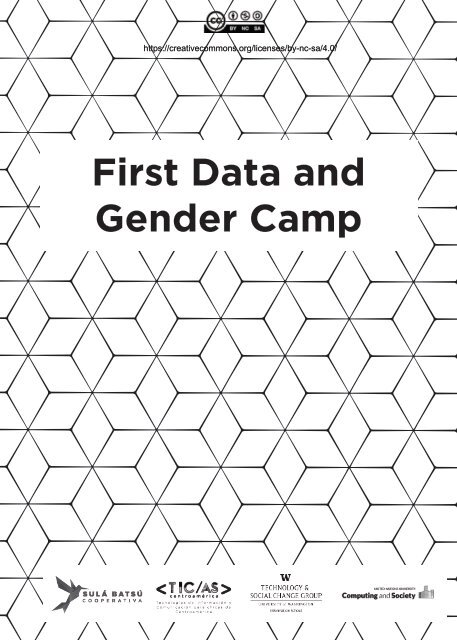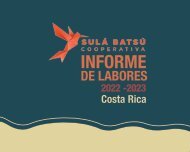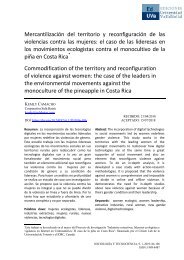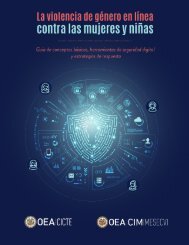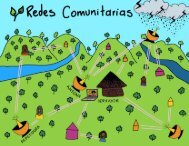Libro de trabajo(traducido)
Create successful ePaper yourself
Turn your PDF publications into a flip-book with our unique Google optimized e-Paper software.
https://creativecommons.org/licenses/by-nc-sa/4.0/<br />
First Data and<br />
Gen<strong>de</strong>r Camp
INDEX<br />
Exercise 1<br />
Exercise 2<br />
Exercise 3<br />
Exercise 4<br />
Exercise 5<br />
Exercise 6<br />
Exercise 7<br />
Exercise 8<br />
Exercise 9<br />
Records<br />
P 1<br />
P 2<br />
P 3<br />
P 4-5<br />
P 6<br />
P 7-8<br />
P 9<br />
P 10<br />
P 11-13<br />
P 14<br />
A
Exercise 1<br />
Mark with an X the correct answer<br />
The gen<strong>de</strong>r data only represents women.<br />
YES<br />
NO<br />
The percentage of women who <strong>de</strong>fect from STEM careers is<br />
higher than that of men.<br />
YES<br />
NO<br />
Women leave IT careers because they want to have babies<br />
and family.<br />
YES<br />
NO<br />
The same responsibilities are being given to men and women<br />
in the IT industry.<br />
YES<br />
NO<br />
In Costa Rica, women use the Internet more than men do.<br />
YES<br />
NO<br />
To analyze:<br />
A. Is there anything loose in the <strong>de</strong>signed questions?<br />
B. Who is represented by the results? Who is not represented by the results?<br />
C. Are there any features about the chosen app to capture the data?<br />
D. Was consent requested?<br />
E. Shall we explain what are we going to do with the data?<br />
F. If other techniques (focus groups, interviews, etc.) had been used to<br />
collect the data, would the results have been different?<br />
1
Exercise 2<br />
Color All Territories<br />
A. Indigenous territories<br />
B. Bor<strong>de</strong>r territories<br />
C. Coastal territories<br />
D. Urban territories<br />
E. Marginal urban territories<br />
F. Afro territories<br />
G. Other territories:<br />
2
Exercise 3<br />
Purchasing power VS Access to...<br />
+<br />
Purchasing power<br />
-<br />
Access to<br />
3
Exercise 4<br />
I put myself in the place of those who are going to give me the data<br />
A.<br />
Disability<br />
B.<br />
C.<br />
A.<br />
Cultures<br />
B.<br />
C.<br />
A.<br />
Gen<strong>de</strong>r<br />
B.<br />
C.<br />
A.<br />
Geographical<br />
Origin<br />
B.<br />
C.<br />
A.<br />
Migration<br />
Situation<br />
B.<br />
C.<br />
4
Exercise 4<br />
I put myself in the place of those who are going to give me the data<br />
Socioeconomic<br />
Status<br />
A.<br />
B.<br />
C.<br />
A.<br />
Age<br />
B.<br />
C.<br />
A.<br />
B.<br />
C.<br />
A.<br />
B.<br />
C.<br />
A.<br />
B.<br />
C.<br />
5
Exercise 5<br />
Prepare profiles about people with an inclusion approach<br />
Example:<br />
A person with a motor disability, woman, el<strong>de</strong>rly, Afro-Caribbean,<br />
who lives in a rural area using a mobile phone.<br />
Describe or draw 4 people with an inclusion approach<br />
to data collection..<br />
What challenges does an inclusive approach of all people in all<br />
territories represent for technology <strong>de</strong>velopment?<br />
Elaborate about it, working in four people groups.<br />
6
Exercise 6<br />
Gen<strong>de</strong>r-focused data: One day in college.<br />
Regarding classmates: Women face<br />
more obstacles. Male peers limit their<br />
potential. Male peers un<strong>de</strong>restimate<br />
their skills.<br />
Regarding myself: Feeling<br />
inferior. My time and theirs<br />
is different.<br />
Regarding families:<br />
Ignorance and lack<br />
of support.<br />
Regarding male<br />
and female teachers:<br />
Sexist environment.<br />
Difference in the relationships.<br />
Un<strong>de</strong>rvaluation of women's contribution.<br />
Regarding female classmates:<br />
Survival strategies. Competition<br />
to <strong>de</strong>monstrate their value.<br />
Lack of opportunities<br />
for sorority building.<br />
Regarding universities:<br />
Lack of support and company.<br />
A single vision that may not be<br />
interesting to women.<br />
Equal processes<br />
for different people.<br />
Regarding the learning<br />
process: Devaluation<br />
of women's contribution.<br />
Success stories are only<br />
about men. Discriminatory<br />
and competitive<br />
learning processes.<br />
A. There is a difference in the aca<strong>de</strong>mic life of people who study<br />
technology careers according to their condition.<br />
B. Examples of data we should have in or<strong>de</strong>r to inclu<strong>de</strong> everyone.<br />
C. Take one of the i<strong>de</strong>ntified aspects and imagine which data<br />
would allow to inclu<strong>de</strong> the gen<strong>de</strong>r perspective.<br />
Build 4 examples in group with other classmates.<br />
7
Exercise 6<br />
Each group chooses a representative to submit the proposal stating:<br />
What aspect did the group choose?<br />
What data did the group produce?<br />
Why did the group choose this data?<br />
How is this data un<strong>de</strong>rstood according to gen<strong>de</strong>r status?<br />
We put all the proposals together.<br />
Gen<strong>de</strong>r: i<strong>de</strong>ntity chosen by people (male, female, trans,<br />
non-binary, etc.)<br />
8
Exercise 7<br />
Analysis of the cases to be worked.<br />
Read the case.<br />
Based on your own experience, add other elements to analyze<br />
the situation that is presented in the case<br />
Rotate among the cases. Word Café.<br />
Split into different subgroups to work in inclusive data<br />
construction (6 per group)<br />
9
Exercise 8<br />
Gen<strong>de</strong>r, Science and Technology Data - State of the art.<br />
We share the tables we have analyzed about of existing data:<br />
1. About access and use of technology<br />
2. About science and technology education<br />
3. About employment in technological fields.<br />
Analysis in subgroups, by topic.<br />
What do these data tell us? What do not these data tell us?<br />
Who is represented in that data? Who is not represented in that data?<br />
What would be the consequences of being represented or not?<br />
10
Exercise 9<br />
Ketso<br />
First level: What are the most relevant questions you want<br />
to answer about this issue?<br />
Second level: What elements can we break down these<br />
questions with?<br />
Third level: What data already exists to better un<strong>de</strong>rstand t<br />
he elements we previously i<strong>de</strong>ntified? What other data do<br />
we need to better un<strong>de</strong>rstand these elements?<br />
(see resulting table)<br />
11
Exercise 9<br />
Characteristics of the population that gives me the data<br />
12
Exercise 9<br />
Characteristics of the population that gives me the data<br />
13
Records<br />
Permanent consultation record<br />
Who is represented?<br />
Who is not represented?<br />
What are the implications of not being represented?<br />
Permanent reflection sheet<br />
What we are learning:<br />
How am I un<strong>de</strong>rstanding what data is?<br />
Why is it important to have a gen<strong>de</strong>r and social justice<br />
approach to the data-building methodology?<br />
Why is it important to have a social justice and inclusion a<br />
pproach in the <strong>de</strong>sign of technology that captures data?<br />
How does the way data is <strong>de</strong>signed affect inclusion?<br />
Other things we are learning.<br />
14


